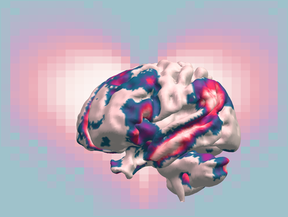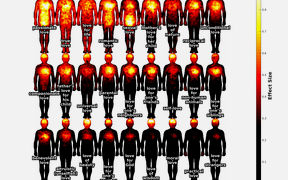Finding love: Study reveals where love lives in the brain

We use the word ‘love’ in a bewildering range of contexts — from sexual adoration to parental love or the love of nature. Now, more comprehensive imaging of the brain may shed light on why we use the same word for such a diverse collection of human experiences.
‘You see your newborn child for the first time. The baby is soft, healthy and hearty — your life’s greatest wonder. You feel love for the little one.’
The above statement was one of many simple scenarios presented to fifty-five parents, self-described as being in a loving relationship. Researchers from Aalto University utilised functional magnetic resonance imaging (fMRI) to measure brain activity while subjects mulled brief stories related to six different types of love.
‘We now provide a more comprehensive picture of the brain activity associated with different types of love than previous research,’ says Pärttyli Rinne, the philosopher and researcher who coordinated the study. ‘The activation pattern of love is generated in social situations in the basal ganglia, the midline of the forehead, the precuneus and the temporoparietal junction at the sides of the back of the head.’
Love for one’s children generated the most intense brain activity, closely followed by romantic love.
‘In parental love, there was activation deep in the brain's reward system in the striatum area while imagining love, and this was not seen for any other kind of love,’ says Rinne. Love for romantic partners, friends, strangers, pets and nature were also part of the study, which was published this week in the Cerebral Cortex journal, Oxford University Press.

According to the research, brain activity is influenced not only by the closeness of the object of love, but also by whether it is a human being, another species or nature.
Unsurprisingly, compassionate love for strangers was less rewarding and caused less brain activation than love in close relationships. Meanwhile, love of nature activated the reward system and visual areas of the brain, but not the social brain areas.
Pet-owners identifiable by brain activity
The biggest surprise for the researchers was that the brain areas associated with love between people ended up being very similar, with differences lying primarily in the intensity of activation. All types of interpersonal love activated areas of the brain associated with social cognition, in contrast to love for pets or nature — with one exception.
Subjects’ brain responses to a statement like the following, on average, revealed whether or not they shared their life with a furry friend:
‘You are home lolling on the couch and your pet cat pads over to you. The cat curls up next to you and purrs sleepily. You love your pet.’
‘When looking at love for pets and the brain activity associated with it, brain areas associated with sociality statistically reveal whether or not the person is a pet owner. When it comes to the pet owners, these areas are more activated than with non-pet owners,’ says Rinne.
Love activations were controlled for in the study with neutral stories in which very little happened. For example, looking out the bus window or absent-mindedly brushing your teeth. After hearing a professional actor’s rendition of each “love story”, participants were asked to imagine each emotion for ten seconds.
This is not the first effort at finding love for Rinne and his team, which includes researchers Juha Lahnakoski, Heini Saarimäki, Mikke Tavast, Mikko Sams and Linda Henriksson. They have undertaken several studies seeking to deepen our scientific knowledge of human emotions. The group released research mapping subjects’ bodily experiences of love a year ago, with the earlier study also linking the strongest physical experiences of love with close interpersonal relationships.
Not only can understanding the neural mechanisms of love help guide philosophical discussions about the nature of love, consciousness, and human connection, but also, the researchers hope that their work will enhance mental health interventions in conditions like attachment disorders, depression or relationship issues.
You can upload original images here.
Contact information:
Pärttyli Rinne
Researcher
parttyli.rinne@aalto.fi
Phone: +358 40 445 9081
Where do we feel love?
New research sheds light on where and how we feel different kinds of love

Read more news

Deepika Yadav leverages technology to improve women's health
Deepika Yadav recently began as an assistant professor at the Department of Computer Science in the field of human-computer interaction (HCI) and interaction design for health and wellbeing.
Study: Internal combustion engine can achieve zero-emission combustion and double efficiency
A new combustion concept that utilizes argon could completely eliminate nitrogen oxide emissions from internal combustion engines and double their efficiency compared to diesel engines.
A new way to measure contagion: the gut bacterium behind blood poisoning can spread like influenza
Neither the antibiotic-resistant nor the highly virulent strains are the most transmissible.






